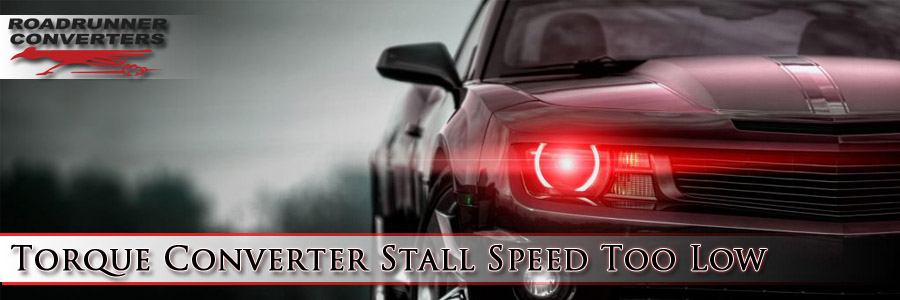Are you searching for “Torque Converter Stall Speed Too Low” while trying to diagnose why your torque converter isn’t handling the power like you need it to? This article is designed to help you understand torque converters better, and know how you can address when their stall speeds are too low.
Here are some questions you should consider as we get started. Click each to learn more.
- When should I consider a trans-brake?
- Does stall speed affect normal street driving?
- When selecting a converter, should you only consider the stall speed?
- Why is proper stall speed important?
- How can I determine the stall speed of my converter?
- Why is stall speed different with the same converter on different engines?
- Is an additional oil cooler required with high performance converters?
- What are flash stall, brake stall and true stall?
Stall speed
The torque converter stall, this is a term that is common, however, it is also common for it to be misunderstood. It means that the converter is going to keep the engine speed at a certain speed and will not let the engine go any faster than that. Stall means speed and converter means to control that speed. One could also think of it as ‘the engine stalls’. Engine being the keyword here!One of the functions of the engine’s peak torque is the converter. The converter is what causes the stall when the engine reaches a certain speed, and the speed at which the stall will occur depends on the given converter.
Obviously, the stall speed for a given converter is not going to be coupled in the same way for a tamed small engine block as it would be in a big block engine that has muscle features added to it. It is significant to take into account when comparing stall speeds that it depends on the engine, for there are many factors to consider, such as whether or not it is a big block engine, a small engine, and whether or not the engine has been customized. The best way to determine a true converter stall is to use a trans-brake.
You also are not going to get a true stall value using the method of locking the wheel brakes, because this does not generally produce its true value, and the reason for this is that the engine’s power can sometimes make the wheel turn by over powers the brakes. If the stall speed has been determined using this method, it should be mentioned when talking about the stall speed for the means of determination. Determining the stall speed with flash stall is done by launching when at full throttle, then observing what the peak speed obtained is when its launched.
The correct stall speed to fit your vehicle will need to be selected by matching it to the vehicles engine peak torque, as well as the engine’s torque curve shape, and the vehicles weight. Generally, a stall speed when selected to go with your converter is going to be 500 – 700 rpm’s below the engine’s peak torque. At the speed of 700 rpm’s it will leave room for the process of the torque reserve when taking off, and if someone tries to select the stall speed that has never done it before they should under estimate it rather than over estimate.
If the output of the torque is over estimated, the converter’s stall speed will be too low, which will make the car start out slow, with a slow ET. When a car’s stall speed has been properly selected the car will take off much better and have a better ET. Knowing this will help in understanding the significance of consulting a professional when considering selecting a stall speed.
The stall speed has been balanced off to fight off inefficiency after taking off. To get the desired stall for the cars performance after taking off can be as costly as it would be to select and install an improper stall speed in the first place. There has been careful selection and changes of design made on the optimum converter, making changes to the turbine, stator, and impeller.
Torque Converter FAQ
These are the most common questions we get regarding torque converter issues. Take a look at what other people are asking to find the answer to your question. If you can’t find it in this list please give us a call so we can help you out by calling 602-437-2301.
How do I know what the stall speed is for my converter?
Unless your vehicle has been equipped with a Transbrake, which locks the drive chain, the stall speed will be very hard in determining. If testing your stall speed by means of holding your wheel brakes at the same time the engine is running against locked brakes, it generally will result in the wheels rotating before the true stall speed has been reached. The engine merely over powers the brakes ability to hold the vehicle. The vehicle will no longer be at stall once it begins rotating.
When someone speaks of a brake stall remember, this is not a true stall by any means. There is however, an alternative method that can be used to get the stall speed measurement and that is by launching with a wide open throttle and pay attention to the what the engine’s RPM reaches during the launch. This is referred to as flash stall.
Why is it that having a proper stall speed is important?
The stall speed needs to be matched up with the engines performance, the vehicles weight, gear ratio, and tire size. A proper selection of the stall spec makes for a faster launch, with a better 60 feet time and with the ET. It is important to specify these parameters at the time of ordering your converter if you want to assure satisfaction.
Why are stall speeds different on different engines even if it is the same converter being used?
It is the engine’s output that really determines the stall speed for each given converter. This can cause the converter that you have been previously been using not to be as adequate if you have made improvements to your engine’s performance. Particularly true when the use of a used camshaft is being used to improve your vehicles performance.
All of the following can affect your stall speed: improving the heads, carburetion, and installing turbos and/or manifolds. Keep in mind, your stall speed must be matched to your vehicles combination.
What is brake stall, true stall, and flash stall?
The only way to reliably determine the truest stall speed would be in conjunction of a Transbrake. The wheel brake stall can be determined if you lock the wheel brakes while engine runs against locked brakes.
When selecting a converter, is the only consideration stall speed?
Even though the stall speed is important, it is not the only means in which to consider selecting a converter. When launching, the Torque multiplication and having a high end efficiency are still equally as important. You can get the stall speed in several ways that is going to cripple the converter in some other ways. You can obtain the stall speed at the expense of it causing something to be loose going at lower speeds and/or losing its performance when going at high speeds once you have launched.
You do not want a converter that causes you to have to sacrifice your vehicles performance further down the road, instead, you need a converter that is going to produce the correct stall from the get – go.
Is normal street driving affected by the stall speed?
When you have a good converter the stall speeds of up to around 3,000 RPM’s is not going to affect normal driving. When a converter having a higher stall speed is used a vehicle begins to roll normally. The stall speed can influence a fast acceleration favorably. Stall speeds above 3,000 RPM’s is not satisfactory to use on streets.
Do high performance converters require you to have an additional oil cooler?
Additional cooling can be a good thing, but not necessary for converter with high performance that are used for streets and strip applications. Exercise care anytime run-up is to be made at a start line. If there should be excess time during stall it can put converter at risk because of the heat building up. This kind of heat build-up cannot be saved by having a cooler because of the time it takes to shed the heat.
However, should the vehicle be used for towing, an additional cooler would be a must. There is no need for an additional cooler for normal usage. The converter will be more efficient the better it is designed, and it will generate less heat.
When should a Transbrake be considered?
A Transbrake is for when you want to launch fast, repeatedly. Using the Transbrake will allow engine to launch almost at optimum speed to get the maximum performance at a better 60 feet time with ET. Thus, the reason that proper stall speed is significant. The Transbrake is not suitable for many applications that involve street use and are usually suited for the strip only.


